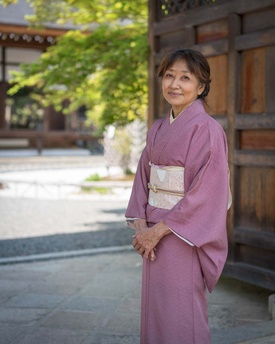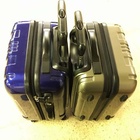The reason for traveling back and forth between Japan and the U.S. was the change in the U.S. political situation
Lana Mariko Sofer came to the United States in 1975. Based in Los Angeles, Lana has been involved for many years in the production of subtitles and dubbing for movies mainly shown in airplanes. Since she lives close to my house, we would occasionally have lunch together, but it was through social media that I learned that she also had a base in Kyoto and traveled back and forth between Japan and the United States. It turns out that in 2017, she was facing a turning point.
"First, my older sister, who had been living in Los Angeles for many years, decided to move to Portugal. She had often traveled to Europe for work, and had always wanted to live there one day. It was around that time that the Trump administration came to power in the United States, and restrictions on Muslims entering the country (Muslim bans) were imposed. My husband and I are not Muslim, but we were still worried about what would happen to America in the future. So my husband suggested that we find a place to escape to overseas, and we decided to sell our house so that we would be able to move quickly. By that time, my father, who we had brought over from Japan, had already passed away, and in September 2017, my mother also passed away."
In 2017, a combination of factors — her sister's emigration plans, a changing political climate, and the passing of her mother — led Lana and her husband, Daniel, to look outside the United States.
"Because I still have Japanese nationality, we decided to go to Japan. Getting a visa is a hassle for other countries, and I had visited Kyoto, where my parents lived, many times from the United States and had always wanted to take my time to see the city. My father was fond of Arashiyama, an area of Kyoto where he lived, so we started looking for a house to buy in Arashiyama. However, unlike in the United States, where you can get a loan at any age, in Japan you can't get a loan once you reach a certain age. There are only a limited number of houses you can buy with cash, and we couldn't find a house that we loved so much that we wanted to buy it, so we ended up renting. Still, it was surprisingly cheap, and I plan to keep working and earn enough to pay for the rent."
The rent that Lana told me in secret was "unbelievably" cheap in Los Angeles, where real estate prices continue to soar. What I was wondering about was the "guarantor." How did she find a guarantor for a rental house in Japan, where she hadn't had any family for 40 years? "Someone who worked at my father's clinic, who was a doctor, became my guarantor. Even when my father closed his clinic in Osaka and worked as a doctor in Kyoto, he would often visit us, and I would see him when I returned home." However, Lana added that in many cases, a guarantor is still required to be a family member or relative. "We don't have a credit history in Japan, so a guarantor is important. We offered to pay the rent in advance to the landlord, but they said they couldn't accept it. They said it was because they thought it was possible that someone could be a terrorist who paid the money and used the house as a hideout to commit a crime."
In the future, I plan to return to the United States where my son lives.
Thus, in 2018, he started living in a rented house in Kyoto, occasionally returning to Los Angeles to enjoy surfing, a hobby that is difficult to pursue while living in Kyoto. We asked him about the good things about Japan and America that he has come to see since commuting back and forth.
"Japan has a great public safety record. Around our house in Kyoto, there are many houses with unmanned stands selling organic vegetables and other things. When my husband first saw them, he said, 'Something will get stolen' (laughs). Then there's health insurance, which has been an issue for many years. When you go to the hospital in Japan, you're told it's only 1,000 yen for the first visit, and you're surprised at how cheap it is. Then there's driving. As I get older, I find driving more of a hassle, especially at night. In Japan, there are many options such as trains, buses, and taxis that mean you don't have to drive. On the other hand, one thing that worries me about Japan is the lack of access for people with disabilities. Compared to 10 years ago, there are more elevators in stations and other places, but even those are still too narrow for a wheelchair to fit in, and this bothers me a lot."
What about the good things about America? "When I went to America in 1975, Jerry Brown was the governor of California. He was attractive and felt close to home, unlike Japanese politicians. I was very impressed. Another big difference is that in America the people can directly elect their president. When you're in America, you get the feeling that you're taking part in society, and that by taking part you can make a difference. I think that's the charm of America."
Now, in 2020, in the midst of the COVID-19 pandemic, Lana stayed in Los Angeles from June to November. During that time, her husband Daniel stayed in Kyoto alone because the future of the entry and exit restrictions imposed on Americans was uncertain. "Daniel volunteers for the English media outlet Kyoto Journal, which has a 30-year history. Sometimes he works as a photographer, sometimes as a designer. Many of his fellow volunteers are foreigners living in Kyoto."
Lana herself is also keen to make new friends. "I'm currently enrolled in a correspondence course at Kyoto University of the Arts to study textiles, which I've always been interested in. I thought that if I took a correspondence course, I'd be able to attend lectures when I returned to the US. They also have in-person classes, so I've been able to make new friends." Outside of university, she says, she has been blessed with the opportunity to meet experts in Japanese traditional culture, such as temple gardeners and Buddhist sculptors (sculptors who specialize in Buddhist statues), due to the location of Kyoto.
Although Lana and her husband are enjoying life in Kyoto, it seems they do not plan to make Japan their final residence. "If we didn't have children, we would probably live in Kyoto forever. But we have a son and his wife who live in New York, and we are expecting a grandchild this summer. What this pandemic has made us realize is how important it is to be close to family. So, after living in Kyoto for a while, we think we will return to the US, where our son is."
Like the people I have interviewed so far, Lana also says that she ultimately wants to live "where her children are." I hope she enjoys her life in Kyoto for as long as possible until then, but even without my wishing for it, I could see from her smile on the Zoom screen how fulfilling her days are.
© 2021 Keiko FUkuda







